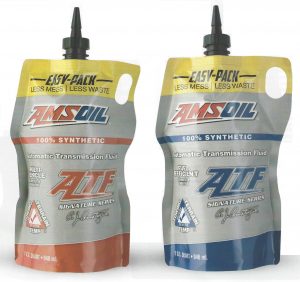By John Baker From The AMSOIL Blog, October 24, 2016
How often you should change transmission fluid depends on your vehicle and driving habits.
That’s a cop-out. But, it’s true.
Automatic-transmission-fluid-change recommendations vary from one original equipment manufacturer (OEM) to another. Plus, if your driving habits are like most motorists and fall under the “severe” designation (towing, hauling, daily short trips less than 10 miles, etc.), many OEMs recommend changing transmission fluid more frequently.
Check your owner’s manual
Start by looking in your vehicle owner’s manual. It’ll provide maintenance recommendations, typically in a table in the back.
The 2017 Ford F-150, for example, requires automatic transmission fluid changes every 150,000 miles in normal service, 30,000 miles if you tow and haul. My wife’s Honda CR-V calls for transmission fluid changes every 90,000 miles in normal service, 30,000 miles in severe service. Some transmissions are considered “fill-for-life.”
Should you change transmission fluid in a filled-for-life transmission? Find out here.
These differences illustrate the importance of digging your owner’s manual out from under the napkins and broken sunglasses in your glove box and checking for yourself.
Go by the book, but when you don’t…
But, really, how many of us dutifully follow the recommendations in our owner’s manuals down to the mile? Many motorists completely forget about their transmission until it begins to shift erratically. Out of sight, out of mind, right?
Not good, especially if you tow or haul.
AMSOIL Tech Tips: Automatic Transmission
Heat kills transmissions
Over time, transmission fluid oxidizes (chemically breaks down). High heat generated from towing and hauling speeds the process. Fluid that has broken down can cause sludge and varnish to form, which clogs narrow oil passages and contributes to clutch glazing. Soon, your vehicle can begin to shift hard, jerk or hesitate.
Find out about common fixes for a transmission that jerks or hesitates here.
In these cases, wouldn’t it be great to use a transmission fluid formulated with reserve protection against heat in case life gets in the way of recommended maintenance?
Reserve heat protection
AMSOIL Signature Series Synthetic Automatic Transmission Fluid’s built-in reserve protection means it lasts for twice the OEM’s severe-service drain interval. That means you can rest assured your transmission is protected, even if service is delayed.
In fact, after 180,000 miles in taxi cabs driven in the searing Las Vegas heat, Signature Series retained 83 percent of its oxidation inhibitors, proving its long-lasting resistance to thermal breakdown. Plus, the used fluid with 180,000 severe-service miles on it still met the Chrysler ATF+4 standard’s new fluid requirement for resistance to thermal breakdown.
Symptoms of low transmission fluid
It’s not just heat that leads to poor shifting. Low transmission fluid can also present a number of problems, including…
• Inconsistent, jerky shifts
• Hesitation
• Surging
• Increased transmission temperatures
Low fluid = poor shifting
Transmission fluid serves a number of vital functions, one of which is to act as a hydraulic fluid to enable shifting. When your vehicle’s computer tells the transmission to change gears, hydraulic pressure (provided by the fluid) squeezes a series of plates together inside a clutch pack to connect the engine to the transmission output shaft and route power to the wheels.
Low fluid can result in the transmission fluid pump drawing air into its inlet. When air and fluid mix, they create foam, which reduces hydraulic pressure and interferes with the crisp, consistent shifts you desire when driving.
Low transmission fluid can also prevent the torque converter from filling completely, which reduces torque transfer and causes hesitation and lost power. In extreme cases, the vehicle won’t even move unless you rev up the engine.

Which is better? A transmission flush or a pan drop? Find out here.
Low transmission fluid can invite wear
Transmission fluid also lubricates the gears, clutch plates and seals. It forms a protective layer between meshing gear teeth that prevents metal-to-metal contact and helps reduce wear. It helps prevent wear on the clutch plates, which bear significant friction during gear shifts. The fluid also lubricates seals and keeps them pliable so they don’t dry out and leak.
Low fluid can prevent formation of a strong, consistent lubricating film on components, inviting wear. Foam bubbles can collapse when they pass between gear teeth, allowing metal-to-metal contact and further accelerating wear.
Check your transmission fluid
To keep your vehicle running – and shifting – at peak performance, check the fluid about once a month to ensure the correct level. Check out this post on how to check your transmission fluid. (Note: This Video Does Not Apply To Fill For Life Transmissions Which Normally Don’t Have A Dipstick.) If the fluid is consistently low, visit a mechanic to find out why and have the problem fixed.

